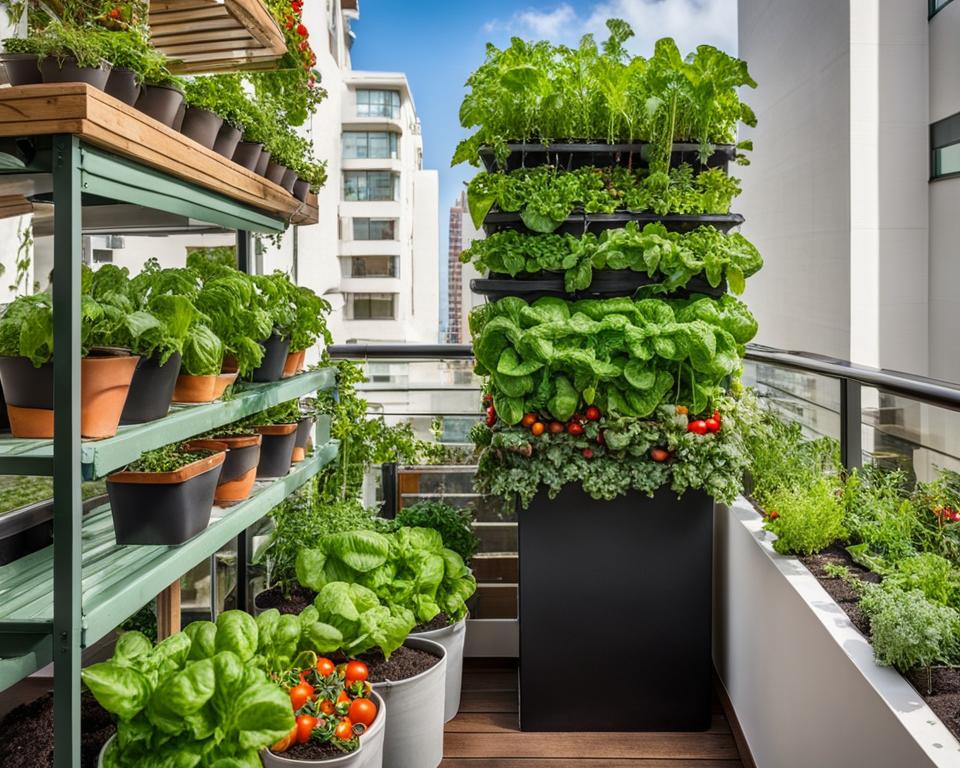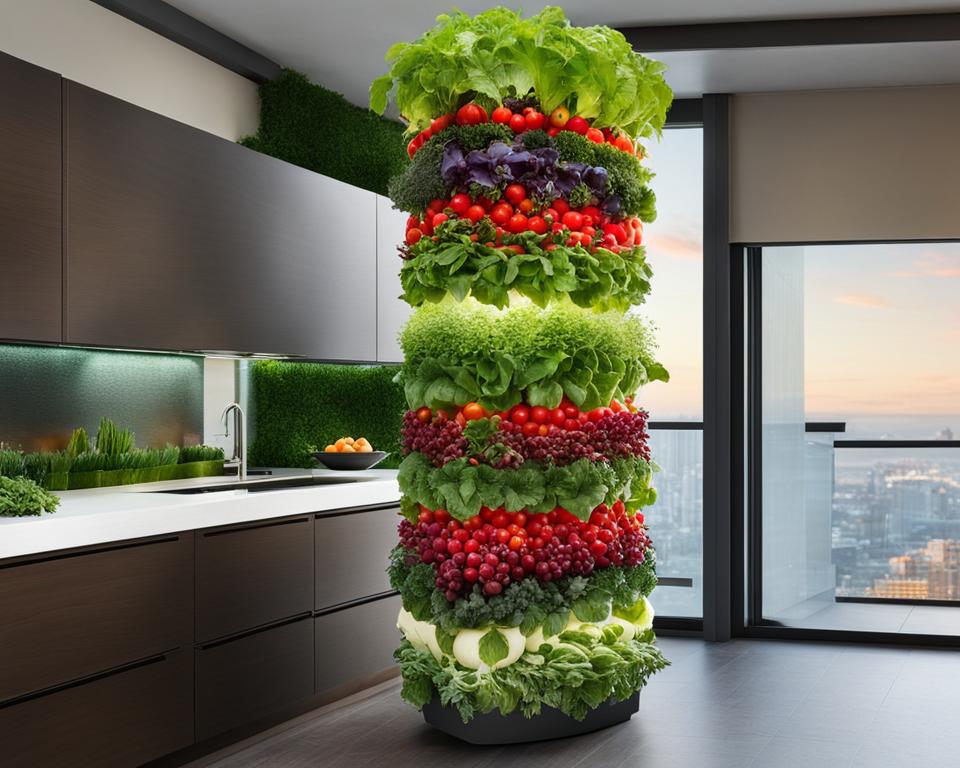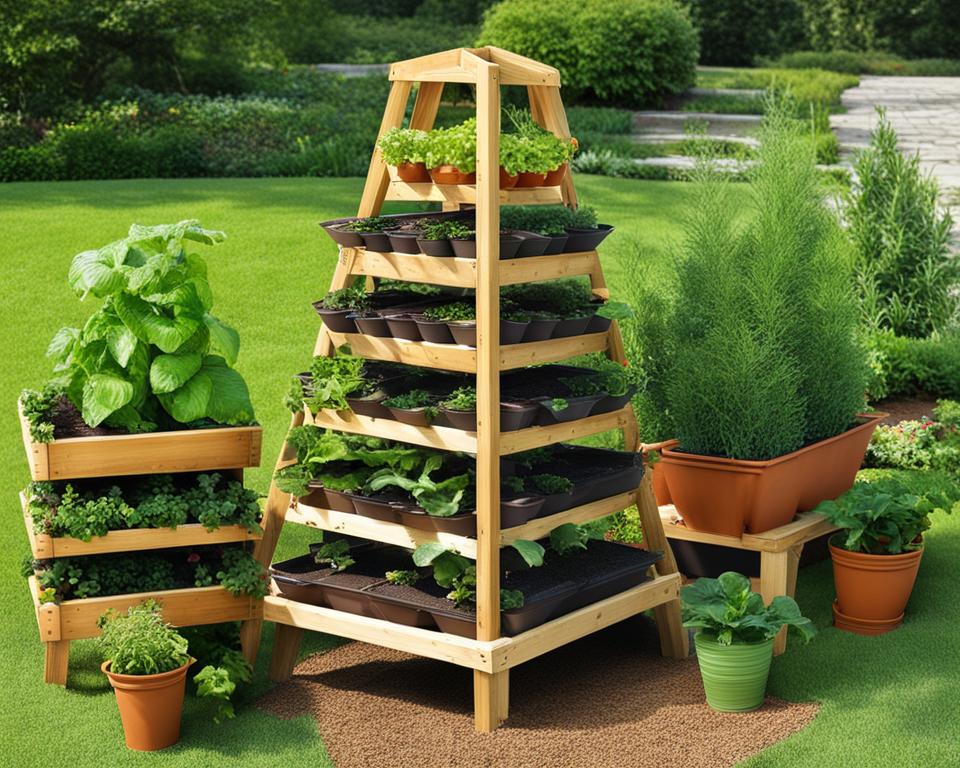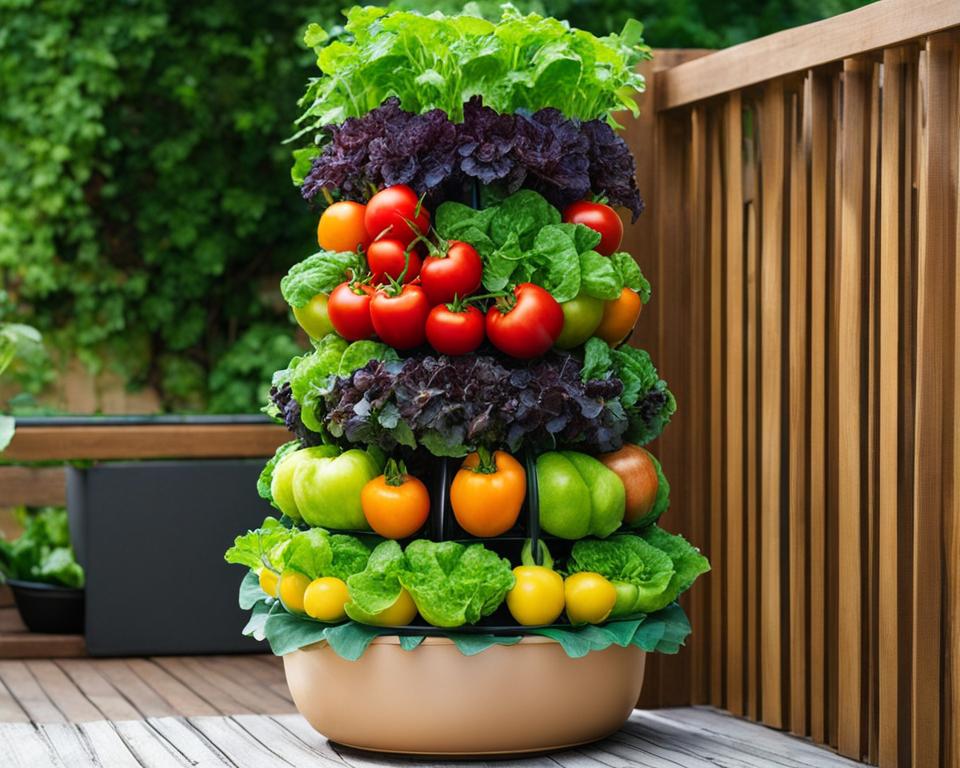For gardening enthusiasts in urban areas or small living spaces, the concept of a food vertical gardening tower can be a game-changer. This innovative solution allows you to grow your own fresh fruits, vegetables, and herbs right on your patio or balcony, making the most of the limited space available. In this article, we’ll introduce you to the wonderful world of vertical garden for food and explain how it offers a space-efficient way to enjoy homegrown produce all year round.
Key Takeaways
- Vertical gardens for food can transform small spaces into productive gardens.
- The concept of a food vertical gardening tower offers efficient use of vertical space.
- These space-saving gardening solutions are suitable for urban environments and small patios.
- Vertical food gardens can provide fresh produce year-round, regardless of traditional growing seasons.
- Ergonomics, accessibility, and eco-friendly benefits make vertical garden towers an attractive choice for gardeners of all skill levels.
- Selecting the right tower, location, and plants are essential steps for a thriving vertical garden for food.
Introducing the Space-Saving Solution: Food Vertical Gardening Towers
As urban areas continue to expand and people find themselves pressed for space, innovative space-saving gardening solutions have become a necessity. One such solution that is gaining popularity among garden enthusiasts is the food growing tower. Unlike traditional horizontal gardens, these vertical food garden towers utilize vertical space, allowing individuals to grow vegetables, fruits, and herbs efficiently.
A vertical food garden tower is designed to maximize crop production while minimizing the required ground area. By stacking layers of growing containers or shelves, these towers create a compact and visually appealing garden that thrives in both small and large spaces. With advances in gardening technology, the efficiency and functionality of vertical gardening have significantly improved, making it an ideal approach for modern urban lifestyles.
“Vertical food garden towers enable individuals to cultivate fresh, homegrown produce in their own space, regardless of how small it may be.”
Main Components of Vertical Food Garden Towers
A typical vertical food garden tower consists of the following components:
- Vertical support structure
- Stackable growing containers or shelves
- Watering and irrigation system
- Mounting hardware or stand for balance and stability
These components are designed to work together, creating an easy-to-use and low-maintenance gardening system. Materials used in the construction of vertical food garden towers vary, including durable plastic, metal, and wood.
Variety of Food Growing Tower Systems
There are diverse types of food growing tower systems available in the market, tailored to accommodate different preferences, spaces, and requirements:
- Hydroponic Tower Systems
- Soil-Based Tower Systems
- Combination Tower Systems (Hydroponic and Soil-Based)
- Modular Wall-Mounted Tower Systems
Regardless of the chosen system, the goal remains the same: efficiently grow fresh produce by maximizing vertical space.
Benefits of Food Vertical Gardening Towers
| Benefit | Description |
|---|---|
| Space Efficiency | By utilizing vertical space, vertical food garden towers free up ground area, making them perfect for small balconies, patios, and rooftops. |
| Ease of Maintenance | Vertical gardens require less weeding, pest management, and manual watering, reducing the time and effort spent on garden maintenance. |
| Accessibility | With plants grown at various heights, vertical garden towers allow individuals to tend to their plants with minimal bending and stretching, making gardening easier and accessible to all abilities and ages. |
| Higher Yields | By optimizing available space and growing conditions, vertical garden towers result in higher crop yield compared to traditional horizontal gardens. |
As urban environments continue to evolve, food vertical gardening towers offer an innovative, space-saving, and efficient solution for garden enthusiasts. By embracing vertical gardening methods, you can cultivate fresh vegetables, fruits, and herbs in even the smallest outdoor spaces, enhancing your gardening experience and sustainability initiatives.
The Benefits of Vertical Gardening Towers for Food Production

Vertical gardening towers provide a revolutionary approach to food production, especially for those with limited space or who seek sustainable gardening practices. We will thoroughly explore the various benefits associated with using a tower garden for food production to help you understand why this innovative approach is becoming increasingly popular among home gardeners and urban dwellers alike.
Year-Round Harvests in Limited Spaces
One of the most significant benefits of vertical gardening is the opportunity for year-round harvests, even in small spaces. Traditional gardens usually revolve around seasonal growing cycles, but with a vertical tower garden for food, you can defy these constraints by continuously producing fruits, vegetables and herbs—practically anytime, anywhere.
Vertical gardening in small spaces also gives you the flexibility to grow plants that may not thrive in the confined area of a traditional garden. This enables you to enjoy a diverse array of produce, regardless of the season or the size of your available space. The opportunity for year-round harvests also means more homegrown produce, ultimately resulting in a substantial reduction of your grocery bill.
“One of the great things about vertical gardening is that you can easily create a microclimate for your plants, allowing you to grow and harvest produce all year long.”
Improved Accessibility and Ergonomics for Gardeners
An ergonomic garden design is essential for maintaining a comfortable and enjoyable gardening experience, and vertical towers deliver on this front. Accessible gardening with vertical towers significantly reduces the physical strain that often accompanies traditional gardening activities like bending, squatting, and stretching.
Tower gardens provide easy access to all plants, making maintenance and harvesting much more manageable for individuals of all ages and abilities. Furthermore, the vertical nature of the garden eliminates the need for extensive hunching over to plant, water, or pick your produce. As a result, gardening becomes a more inclusive and enjoyable activity for a broader range of enthusiasts, from young children to seniors with mobility challenges.
Eco-Friendly and Sustainability Advantages of a Tower Garden for Food
Vertical gardening contributes to eco-friendly and sustainable living in several ways. For starters, tower gardens require less water than traditional gardens.}- the vertical design ensures that water runs down from the top, making efficient use of every drop. Reduce your water usage and contribute to conservation efforts by adopting a tower garden for food production.
Another advantage of vertical towers is the reduced dependency on chemical fertilizers. Many tower garden systems are designed to utilize natural composting methods, cultivating a nutrient-dense growing environment where your plants can thrive. This organic approach leads not only to healthier plants but also reduces contamination from chemicals found in synthetic fertilizers.
Finally, vertical gardening for food production can significantly reduce your carbon footprint. When you grow more of your own food, there’s less need for transportation, which ultimately means fewer greenhouse gas emissions generated. By investing in sustainable tower gardens, you can do your part to promote a healthier planet while reaping the benefits of fresh, delicious produce grown at home.
In conclusion, embracing vertical gardening towers for food production offers several fantastic benefits. You can enjoy year-round harvests in limited spaces, improve the accessibility and ergonomics of your garden, and contribute to an eco-friendly and sustainable lifestyle. With these advantages, it’s no wonder vertical gardening is gaining momentum in urban and small-space environments.
Choosing the Right Food Vertical Garden System for Your Needs

Selecting the best food vertical garden system can be a daunting task due to the wide variety of options available. However, investing some time in personalizing your vertical gardening solutions can produce fruitful results in the long run. Here are crucial factors to consider when choosing the right vertical garden tower that suits your needs.
-
- Size and Space
Consider the available space for your vertical garden in relation to your desired produce yield. You may choose between smaller, compact systems for patios or larger, more expansive options for bigger gardens.
-
- Cost and Budget
There is a range of vertical gardening systems with varying costs. Establish your budget, and evaluate the long-term return on investment of your preferred system, factoring in its durability, yield potential, and maintenance requirements.
-
- Type of Produce
Determine the type of plants you wish to cultivate, as some vertical gardens may only accommodate specific crops while others offer more versatility.
-
- Maintenance Considerations
As with any garden, vertical systems require dedicated maintenance. Assess the level of upkeep you’re comfortable with, considering elements like watering, fertilizing, and pruning.
Comparing popular vertical garden systems based on these factors can help you make an informed decision. The table below presents a brief overview of some well-regarded options.
| Product | Size | Cost | Type of Produce | Maintenance |
|---|---|---|---|---|
| Garden Tower 2 | 24″ x 24″ x 43″ | $$ | Fruits, veggies, herbs | Moderate |
| Greenstalk Vertical Planter | 19″ x 19″ x 47″ | $ | Fruits, veggies, herbs | Low |
| Tower Garden | 26″ x 26″ x 36″ | $$$ | Fruits, veggies, herbs | Low |
| Lechuza Cascada Stackable Planter | 12″ x 12″ x 27″ | $ | Fruits, veggies, herbs | Low |
While researching, read reviews and gather insights from fellow gardeners to further aid in your decision-making process. Ultimately, the optimal choice will be contingent upon your individual needs, preferences, and constraints.
Remember: a well-selected and personalized vertical gardening system can bring immense satisfaction and productivity. Investing time and effort now ensures long-lasting benefits in the future.
Setting Up Your Food Growing Tower: A Step-by-Step Guide

Creating a thriving food vertical gardening tower begins with a proper setup. In this section, we will go through the step-by-step process of setting up a vertical garden for food production, covering optimal location selection, assembly, and plant choices.
Selecting the Perfect Location for Your Vertical Food Garden Tower
Finding the optimal location for your vertical garden is essential to its success. When positioning food towers, consider these factors:
- Light exposure: Most plants require at least six hours of sunlight per day. Ensure your garden tower receives an adequate amount of sunlight by placing it in a bright area.
- Stability: Choose a flat surface with good drainage and wind shelter, reducing the chance of your vertical garden toppling during heavy winds or accumulating excess water at the base.
- Maintenance and harvesting convenience: Position your food tower garden in an accessible area, making it easy for you to water, fertilize, and harvest your produce.
Assembling Your Vertical Gardening Tower for Food
Now that you’ve chosen an ideal location for your vertical garden, the next step is assembling your vertical gardening towers. Follow the manufacturer’s guidelines provided with your garden tower. The following points will aid you in building a food tower garden:
- Make sure you have all necessary components and tools on hand before beginning the assembly process.
- Assemble the tower according to the manufacturer’s instructions, ensuring that all parts are securely fastened and the structure is stable.
- Fill the tower with potting mix or another suitable growing medium that provides proper drainage and aeration to the plants’ roots.
- Consider adding a drip irrigation system or self-watering feature to reduce maintenance efforts and keep your plants adequately hydrated.
Choosing Plants Suited for a Food Tower Garden
Not all plants thrive in a vertical gardening environment. To ensure a successful food tower garden, consider these guidelines when selecting plants for tower gardens:
| Plant Selection Criteria | Explanation |
|---|---|
| Root size | Choose plants with small to medium-sized root systems that won’t be overcrowded or stunted in the vertical tower’s limited soil depth. |
| Sunlight needs | Select plants with similar sunlight requirements to ensure they all receive adequate exposure in your specific garden tower location. |
| Growth habits | Opt for plants with compact growth habits that won’t sprawl and compete for space or create excessive shading within the tower. |
Compatible crops for vertical towers include lettuce, spinach, herbs, strawberries, and dwarf tomato varieties. By carefully selecting suitable plants and following the outlined food vertical gardening setup guide, you will be well-equipped for a successful and bountiful food tower garden.
Best Practices for Maintaining a Healthy and Productive Vertical Garden for Food

Maintaining vertical gardens requires diligence and dedication to ensure that your plants in the food tower garden remain healthy and productive. In this section, we will cover several vital techniques to help you maintain a thriving vertical garden while efficiently maximizing your gardening space.
- Watering: Vertical gardens typically require more frequent watering than conventional gardens, as the soil and container capacities may be smaller. Pay careful attention to the moisture levels of the soil, ensuring that it remains evenly moist but not overly saturated. Drip irrigation systems are highly effective at distributing water uniformly across all plants in your vertical garden.
- Fertilizing: The proper balance of nutrients is essential for your plants’ growth and productivity. Adopt a regular feeding schedule, incorporating organic fertilizers or specialized tower garden nutrient solutions for best results. Monitor the health and growth of your plants to ensure they receive the necessary macro and micronutrients.
- Pruning: Proper pruning promotes improved plant productivity, air circulation, and helps maintain the overall aesthetic of your vertical garden. Regularly check for dead or dying leaves and remove them to maintain healthy growth.
- Pest management: Vertical gardens tend to be less susceptible to pests, but still require regular monitoring. Implement natural pest control methods like introducing beneficial insects, using insecticidal soaps or horticultural oils, or the regular removal of diseased plant material to curtail infestations.
- Monitoring plant health: Keep an eye on the growth, color, and general health of your plants. Respond promptly to any signs of distress, such as yellowing leaves or stunted growth, by adjusting watering and nutrient regimens as required.
Remember, consistency is key in maintaining a successful vertical food garden. Regular monitoring and care will allow you to enjoy a bountiful harvest of fresh, homegrown produce all year round.
| Maintenance Task | Frequency | Tips |
|---|---|---|
| Watering | Daily to every few days (depending on climate and container size) | Use a drip irrigation system for even distribution and monitor soil moisture. |
| Fertilizing | Every 2-4 weeks | Utilize organic fertilizers or specialized nutrient solutions tailored to your plants’ needs. |
| Pruning | As needed | Remove dead or dying leaves and maintain proper spacing for improved air circulation. |
| Pest Management | Ongoing | Implement natural pest control methods and monitor for signs of infestations. |
| Monitoring Plant Health | Ongoing | Keep an eye on growth, color, and overall health indicators to address any issues promptly. |
By following these best practices for maintaining vertical gardens, you can enjoy a thriving, healthy, and productive food tower garden in even the smallest of spaces. Happy gardening!
Embracing the Advantages of Vertical Food Gardening
In summary, the adoption of food vertical gardening towers is a game-changing approach to space-efficient gardening in urban or small-sized locations. It not only saves valuable space but offers year-round harvests, improved accessibility, and numerous environmental benefits due to sustainable gardening practices. Additionally, vertical gardens are versatile, with options to personalize your gardening system according to your needs.
We covered essential topics such as choosing and positioning the right food vertical garden tower, how to assemble it, selecting suitable plants, and best practices for maintaining a healthy and productive garden. These guidelines provide a solid foundation for those looking to take their gardening pursuits to a new level, regardless of space constraints.
The advantages of vertical food gardening should not be overlooked, as it presents opportunities for a more sustainable and eco-friendly way of producing homegrown vegetables, fruits, and herbs. Embrace the innovation of food vertical gardening towers to enhance your gardening experience, contribute to a more sustainable future, and enjoy the myriad benefits that come with this space-saving solution.
FAQ
What is a food vertical gardening tower?
A food vertical gardening tower is a space-efficient gardening solution that allows you to grow vegetables, fruits, and herbs vertically, maximizing the use of limited space in urban environments or small patios.
How do vertical gardening towers save space?
Vertical gardening towers save space by utilizing vertical space, allowing you to grow plants upward instead of outward. This innovative design is an excellent solution for those with limited gardening space, such as apartment dwellers, urban gardeners, or those with small patios or yards.
What are the benefits of using a tower garden for food production?
The benefits of using a tower garden for food production include year-round harvests, improved accessibility and ergonomics for gardeners, and eco-friendly and sustainable gardening practices such as reduced water usage, fewer chemical fertilizers, and a smaller carbon footprint.
How do I choose the right food vertical garden system for my needs?
To choose the right food vertical garden system, consider factors like size, cost, types of plants you want to grow, and maintenance requirements. It’s essential to select a system that meets your specific needs and preferences for a successful and satisfying gardening experience.
What is the process of setting up a food growing tower?
Setting up a food growing tower involves selecting the perfect location with proper light exposure, assembling the tower, and choosing appropriate plants based on root size, sunlight needs, and growth habits. Follow the step-by-step guide provided by the manufacturer to ensure a successful setup.
How do I maintain a healthy and productive vertical garden for food?
To maintain a healthy and productive vertical garden for food, follow best practices like regular watering, fertilizing, pruning, pest management, and monitoring plant health. Each vertical garden system may have specific maintenance requirements, so be sure to consult the manufacturer’s instructions for optimal results.
What types of plants are suitable for growing in a food tower garden?
Many vegetables, fruits, and herbs are suitable for growing in a food tower garden, but it’s crucial to select plants with compatible root sizes, sunlight needs, and growth habits. Some popular choices include lettuce, spinach, kale, herbs, strawberries, and cherry tomatoes. Research the specific requirements of the plants you wish to grow and ensure they are well-suited for a vertical garden environment.

